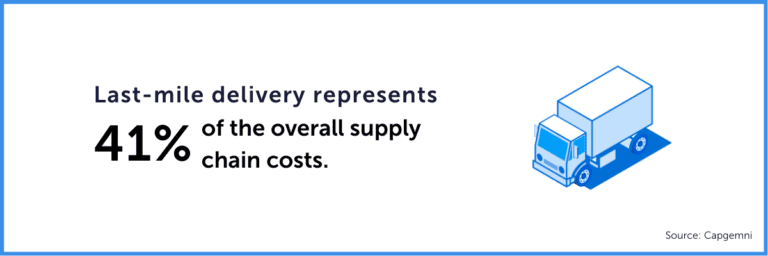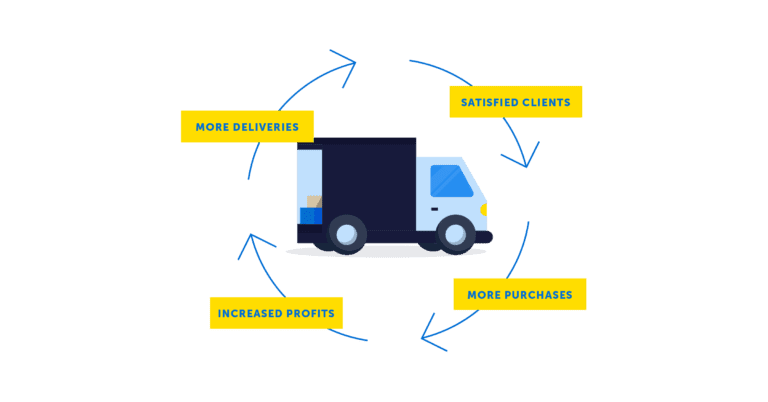Last-Mile Delivery Route Optimization using Data & Solutions
January 13, 2025

The last-mile delivery process is evolving dramatically as e-commerce becomes increasingly popular and omnipresent in our daily lives. Companies with user-friendly online platforms and door-to-door delivery like Amazon and Uber have really stood out from the others and changed expectations in both a B2C and B2B context. As a result, today’s customers don’t settle for anything less than a premium delivery service, with time-of-delivery notifications and real-time tracking. They are sometimes even willing to pay higher fees for transparent, seamless service and faster delivery, which is especially true for younger generations.
However, it is more and more difficult for organizations to meet customer demands while maintaining delivery efficiency and profit margins. Indeed, in addition to being the key to customer satisfaction, last-mile delivery is also the most expensive and time-consuming part of the whole shipping process. Therefore, improving fleet management should not just be about warehousing, sorting, and parceling. Even if last-mile delivery is the very last step, where a physical product is delivered from—be it fulfillment centers or brick-and-mortar retail establishments—until it reaches the doorstep of the end customer’s home represents 41% of the overall supply chain costs.

Regardless of the industry, there will be winners and losers. It is therefore in the best interest of organizations to digitize their last-mile delivery operations and increase the visibility of their process if they want to remain competitive and keep their market share. This is mainly achieved through flawless route optimization, which should include address recognition, high precision address geocoding, and routing algorithms.
Challenges Faced by Last-Mile Delivery Providers
Delivery Efficiency
Delivery efficiency, and by extension, the speed of shipping packages to the customer, are the biggest challenge for last-mile delivery providers. Delivery efficiency covers everything from end-customer interaction to the driver’s problem resolution and ensures companies keep their competitive edge. As a matter of fact, 43% of supply chain managers see inefficiencies in order fulfillment, packaging, and online delivery as a major barrier to implementing last-mile delivery solutions, according to the Capgemini Research Institute.
This challenge is important to consider because, according to a survey of 1,500 consumers:
98% of consumers say that delivery impacts their brand loyalty.
84% report that they are unlikely to buy again after a single bad delivery experience.
87% expect compensation and 52% expect reimbursement or reduced delivery costs when a delivery is later than expected.
Margins and Costs
Maintaining margins and increasing last-mile delivery costs is the second problem encountered by last-mile delivery providers. In 2018, 42% of them saw their margins decrease. This result is impacted not only by oil and fuel costs, toll costs, rest time, and last-mile rates but also by operational efficiency, which brings us back to our number one challenge. Meeting the rising demand in terms of faster and cheaper delivery is a big concern that should encourage companies to invest in tools that calculate cost-optimized routes. Moreover, it would be particularly helpful for complex delivery areas, such as metropolitan or urban areas, where there are more traffic and obstacles.
Customer Service
The third challenge is the difficulty of meeting customer demand to provide them with a seamless and transparent experience. These demands are increasingly specific and require companies to digitize their last-mile logistics to offer a delivery service in line with the latest technological trends. These demands include:
- Same-day or next-day delivery
- Free delivery
- Delivery time notification
- Delivery time rescheduling
- Easy returns
In fact, nearly half of consumers want next-day delivery and a quarter of them want same-day delivery. However, companies must be careful when guaranteeing fast delivery, because if they don’t meet the deadline, it only creates more frustration for the customer. Therefore, they have to find the right balance between customer satisfaction and profitability. If they don’t modernize their operations, they risk losing customers, who will eventually go elsewhere for better and faster service.
Last-Mile Route Planning and Optimization: the First Step Towards a Maximized Strategy
Having route optimization software is the best way to solve the majority of problems encountered by last-mile delivery providers, whether in terms of efficiency, costs, or customer satisfaction. To achieve great results, it is mandatory for them to have address recognition, high precision address geocoding, and routing algorithms.
By combining all that with live maps, apps that follow drivers in real-time, proof of deliveries, feedback surveys, and Direct to Consumer (DTC) as a service, the communication with the customer becomes optimal. In addition, optimizing routes promotes better conditions for drivers and enables precise navigation to reduce overruns and driver dissatisfaction.
Address Recognition and Geocoding
The goal of address recognition is to confirm that an address is reliable and eligible for delivery. This process can be greatly facilitated when retailers have an autocomplete address API on their e-commerce site to suggest verified addresses for the checkout process when customers purchase products online.
Once an address has been correctly recognized, it can be geocoded, which means attaching latitude and longitude coordinates to accurately pinpoint the customer’s locations and avoid delivery errors. Moreover, providers can use a dynamic mapping platform to locate difficult addresses and capture details of hard-to-find or remote locations.
Combined, address recognition and high-accuracy address geocoding allow delivery managers to reduce their fleet operating costs by up to 21%.
Routing Optimization Through Algorithms
Routing algorithms are key to optimizing delivery routes because they take into consideration data in relation to the last-mile delivery process. This data includes the time of day, location, speed limits, vehicle capacity, fleet size, current and historical traffic patterns, delivery windows, and shift times. Afterward, route planning applications can provide real-time updates and feedback on the most efficient routes to take to avoid issues like traffic and canceled deliveries, as well as limitations such as low bridges, vehicle rules, inner-city restrictions, and road closures.
With this information, deliverers can avoid embarrassing situations like in the picture above, give clients accurate and more precise time windows, and have less difficulty meeting deadlines, particularly in urban areas where there are more unexpected issues and limitations than in rural areas. In fact, they can increase the accuracy of the estimated time of arrival (ETA) by up to 25%.

”Every single business is touched by the power of location to know when things are arriving and what’s the estimated time of arrival. ETAs and asset tracking clearly have an impact on the transportation industry.”
– Stuart Ryan, SVP & General Manager, Americas of HERE Technologies
Routing algorithms and route planning also allow drivers to increase stops per tour by up to 30%. More deliveries in a day mean enhanced customer satisfaction, which means more purchases and increased profits.

The Importance of Last-Mile Delivery Analytics for Success
Last-mile delivery analytics are crucial for businesses aiming to improve service quality, efficiency, and customer satisfaction. These analytics provide valuable insights, allowing companies to optimize their operations and adapt to evolving consumer expectations. Key benefits include:
- Real-Time Performance Monitoring:
Track deliveries in real-time to quickly adjust routes, schedules, and driver assignments, minimizing delays and improving on-time delivery rates.
- Customer Preference Insights:
Understand and respond to consumer demands, such as same-day or scheduled deliveries, enhancing the overall customer experience.
- Route and Operational Efficiency:
Identify inefficiencies in routes or driver performance, allowing companies to optimize logistics, reduce fuel consumption, and cut costs.
- KPI Tracking:
Measure key performance indicators (KPIs) like delivery speed, fuel use, and customer feedback to continuously improve delivery operations.
- Proactive Adjustments:
With constant access to analytics, businesses can make real-time changes to improve delivery accuracy and meet fluctuating demand.
By leveraging these insights, organizations can refine their last-mile delivery processes, reduce costs, and maintain a competitive edge in today’s fast-paced market.
The Role of Last-Mile Route Optimization Software
The implementation of last-mile route optimization software is essential for businesses looking to streamline their delivery operations. This type of software utilizes advanced algorithms, routing APIs, and real-time traffic data to create the most efficient routes, minimizing delays caused by traffic, road closures, or unexpected obstacles. By leveraging this technology, companies can significantly reduce fuel consumption and delivery times, which in turn lowers operational costs and increases profit margins.
In increasingly complex urban environments, where traffic congestion and route constraints can hinder delivery efficiency, last-mile optimization software like Spectrum Spatial Routing plays a crucial role. It dynamically adjusts routes based on current conditions, allowing drivers to avoid delays and make accurate deliveries within the promised time window. This not only boosts customer satisfaction, with more timely deliveries and fewer missed windows, but also enhances fleet productivity by maximizing the number of stops per trip.
Moreover, this software integrates seamlessly with other systems, such as real-time tracking and proof of delivery applications, ensuring a transparent and smooth delivery process for both the company and the customer. By adopting last-mile route optimization, businesses can stay competitive in an era where fast and reliable delivery is a key differentiator.
The Future of Last-Mile Delivery Optimization: What’s Next?
As technology evolves, the future of last-mile optimization will be driven by real-time data and AI-powered tools, transforming delivery processes for greater efficiency and sustainability. Below are some key innovations shaping this future.
Autonomous Vehicles and Drones
Autonomous vehicles, drones and robots are poised to revolutionize last-mile delivery by reducing reliance on human drivers and offering faster, more reliable services. Drones, in particular, can bypass traffic and deliver in hard-to-reach areas, while autonomous vehicles and robots allow for round-the-clock operations. These technologies will drastically cut costs and increase delivery speed, especially in congested urban areas.
Enhanced Mapping and Geospatial Technologies
Mapping tools, geospatial data and real-time traffic updates are continually improving, enabling highly accurate routing optimization. Delivery companies will navigate complex environments more effectively, reduce delays, and reach previously inaccessible locations with ease. Predictive mapping technologies will also anticipate roadblocks, ensuring smoother deliveries.
AI-Driven Predictive Analytics
AI will enhance last-mile routing optimization by forecasting delivery demand and planning routes accordingly. Machine learning algorithms will analyze data, such as customer behavior and traffic patterns, to provide real-time adjustments, reducing delivery times and operational inefficiencies. AI-driven solutions will also help maximize fleet utilization and improve customer satisfaction by providing accurate delivery windows.
Sustainability Initiatives
As businesses aim to reduce their environmental impact, last-mile routing optimization will increasingly focus on sustainability. Electric vehicles and delivery consolidation strategies will minimize emissions. Companies that embrace these green technologies will not only reduce their carbon footprint but also align with consumer preferences for eco-friendly services.
How Can Korem Help You With Last Mile Delivery Route Optimization
Korem can give you a hand with your fleet management strategy and make your delivery process more efficient, profitable, and satisfying for customers. Because no solution can claim to be perfect and complete, our expertise and DaaS offering are here to help you compare data and software providers to find the right solution for you. We can even combine several products from our extensive portfolio of partners to create a solution to suit your needs.
Among these quality products are those from HERE Technologies, which offers the richest and most unique road dataset in the market. This strategic partnership enables fleet managers to take control of the delivery process, reduce total costs, improve productivity, and retain drivers while growing their business.
Contact us now to know more about what Korem can do for transportation and logistics companies. We invite you to watch this on-demand webinar on optimizing supply chain logistics with traffic analytics for both middle and last-mile delivery.




